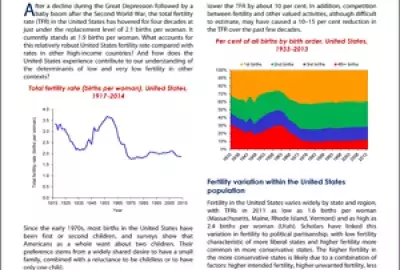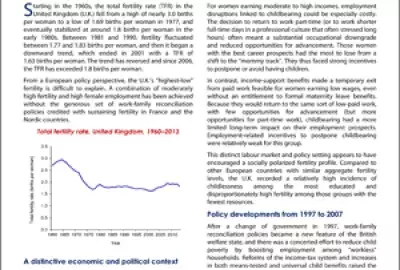
In 1951, childbearing reached a peak in Taiwan Province of China, with a total fertility rate (TFR) of 7.04 births per woman. The government initiated a nationwide family planning programme in 1964, and fertility began a steady decline. Between 1986 and 1997, the TFR hovered at around 1.75 births per woman, but then another period of decline started. By 2003, the TFR had dropped to 1.23 births per woman, making Taiwan Province of China one of the lowest-fertility societies in the world. After falling to 0.895 births per woman in 2010, fertility rebounded in 2012, but only to 1.27 births per woman.
Before the 1980s, fertility went down among women at all reproductive ages. After the 1980s, there was a dramatic reduction of fertility among women under age 30 and a widespread delay of childbearing, and an actual increase in fertility among women aged 35-44.
It is estimated that about two thirds of Taiwan's fertility decline during 1965-1980 was the result of a drop in childbearing among married couples. Since 1980, however, nearly all fertility decline has been associated with a decline in marriage. Within marriage, fertility has actually risen, most likely because couples choose to marry specifically because they plan to have children.
As of 2010, only 4 per cent of women in their early 20s were married. Even among women in their early 30s — the group that currently has the highest fertility — only 53 per cent were married. Given the strong social pressure against childbearing outside marriage, the decline in marriage has not been compensated by an increase in extramarital births.
In 1951, childbearing reached a peak in Taiwan Province of China, with a total fertility rate (TFR) of 7.04 births per woman. The government initiated a nationwide family planning programme in 1964, and fertility began a steady decline. Between 1986 and 1997, the TFR hovered at around 1.75 births per woman, but then another period of decline started. By 2003, the TFR had dropped to 1.23 births per woman, making Taiwan Province of China one of the lowest-fertility societies in the world. After falling to 0.895 births per woman in 2010, fertility rebounded in 2012, but only to 1.27 births per woman.
Before the 1980s, fertility went down among women at all reproductive ages. After the 1980s, there was a dramatic reduction of fertility among women under age 30 and a widespread delay of childbearing, and an actual increase in fertility among women aged 35-44.
It is estimated that about two thirds of Taiwan's fertility decline during 1965-1980 was the result of a drop in childbearing among married couples. Since 1980, however, nearly all fertility decline has been associated with a decline in marriage. Within marriage, fertility has actually risen, most likely because couples choose to marry specifically because they plan to have children.
As of 2010, only 4 per cent of women in their early 20s were married. Even among women in their early 30s — the group that currently has the highest fertility — only 53 per cent were married. Given the strong social pressure against childbearing outside marriage, the decline in marriage has not been compensated by an increase in extramarital births.
Policy Briefs - United Nations Expert Group Meeting on Policy Responses to Low Fertility







